The Merit of Mesquite
I have loved mesquite since I first met with back in 1984. I mistakenly thought it to be a Mahogany variety, perhaps Sapele, something like that, but it was too dense, too hard for those woods. I didn’t work with it again until two or three years later when after my first introduction to it I started to harvest free wood by taking down the trees on pasture land of local ranchers. Ask anyone in Texas about mesquite and they will tell you of its amazing effect in barbecuing beef or for smoking brisket, that it burns hot in the wood-burning stove and that it is a scrub wood hated by farmers and ranchers. I too have seen it as all three but I have also known it for its amazing stability which I link to one thing alone; mesquite knows no equal when it comes to absorbing and releasing moisture. Compare it to any non-tropical or temperate hardwood and you will better understand what I mean.
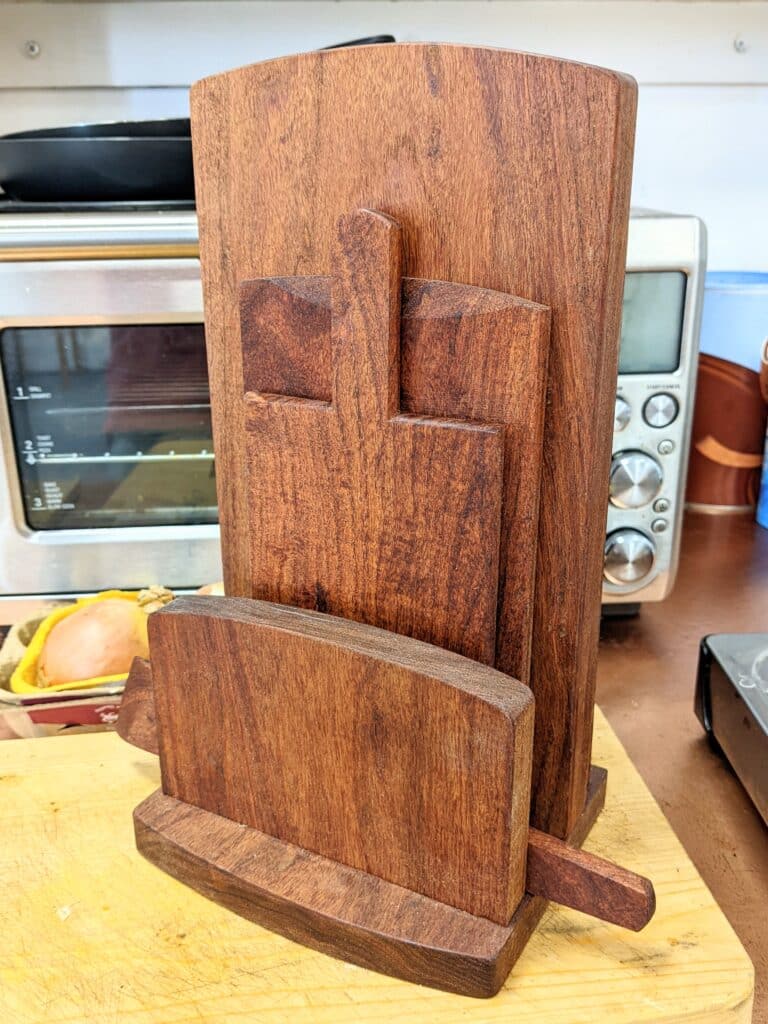
When I first began working with mesquite I was prepared to consider shrinkage as I did other hardwoods growing in the region. Woods like oak, ash, maple, cherry and walnut. When you take down a live tree, slab it and then reduce the moisture content by drying it in a kiln or air-drying, you expect the width of board you cut to shrink considerably from its original cut size. Some woods will shrink an inch or so rendering a 12″ wide board a usable 11″. This variance depends on the wood and whether too it is softwood or hardwood. In an endeavour to experiment with my woods, I soaked and resaturated the fibres of short cuts of all the above-named woods over 24 hours in a bucket of water. My sections were 1″ long along the grain, 6″ wide and 3/4″ thick. My main interest was how the wood would expand across the six-inch width as this is the measurement I needed to know the increase of. Wood shrinkage in its length is so minimal it usually do not affect any of our work. Long story short, all of the domestic hardwoods increased a massive 3/8″ to 1/2″. Very substantial, I thought. Mesquite however increased a mere 1/16″ in width and it is this that I consider the property that gives mesquite its intrinsic resistance toward distortion both in seasoning and in subsequent exposure to extremes of any and all atmospheric conditions surrounding it.
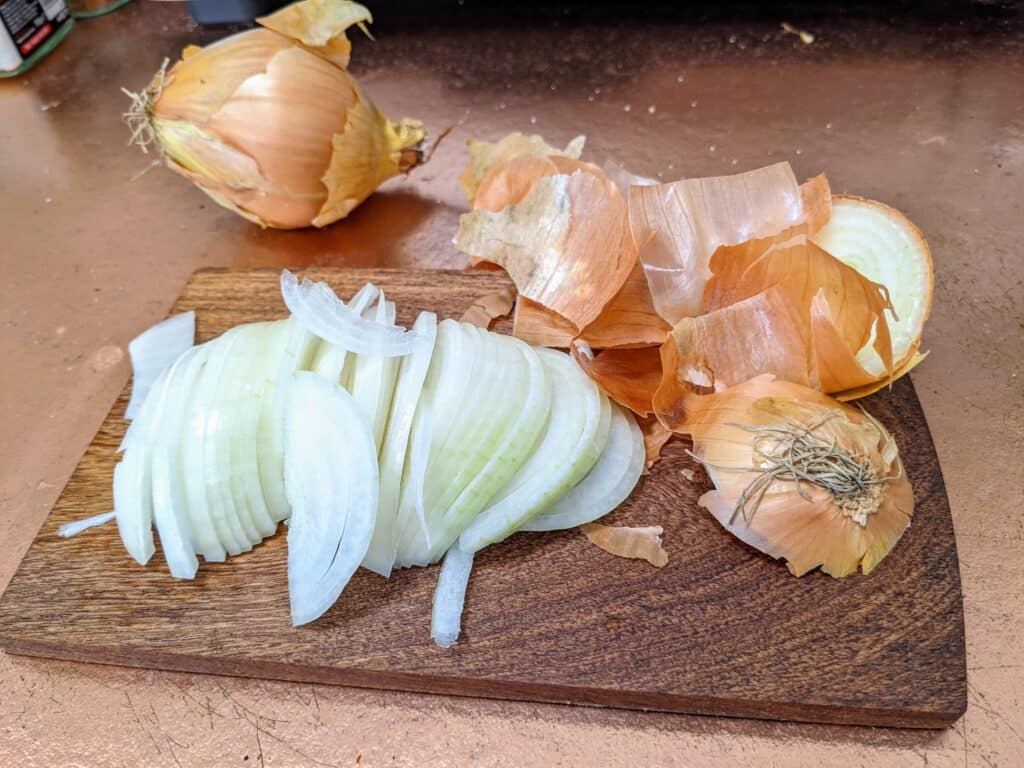
In the kitchen, by the sink, the cooker, the microwave and of course the kitchen sink, I am not too surprised at how quickly general hardwoods degrade as kitchen utensils. Now I am a bit like I am with hand tools, why buy into something that doesn’t last so well. My preferred wood for kitchen support like spatulas and cutting boards, chopping boards and so on is needless to say Mesquite.
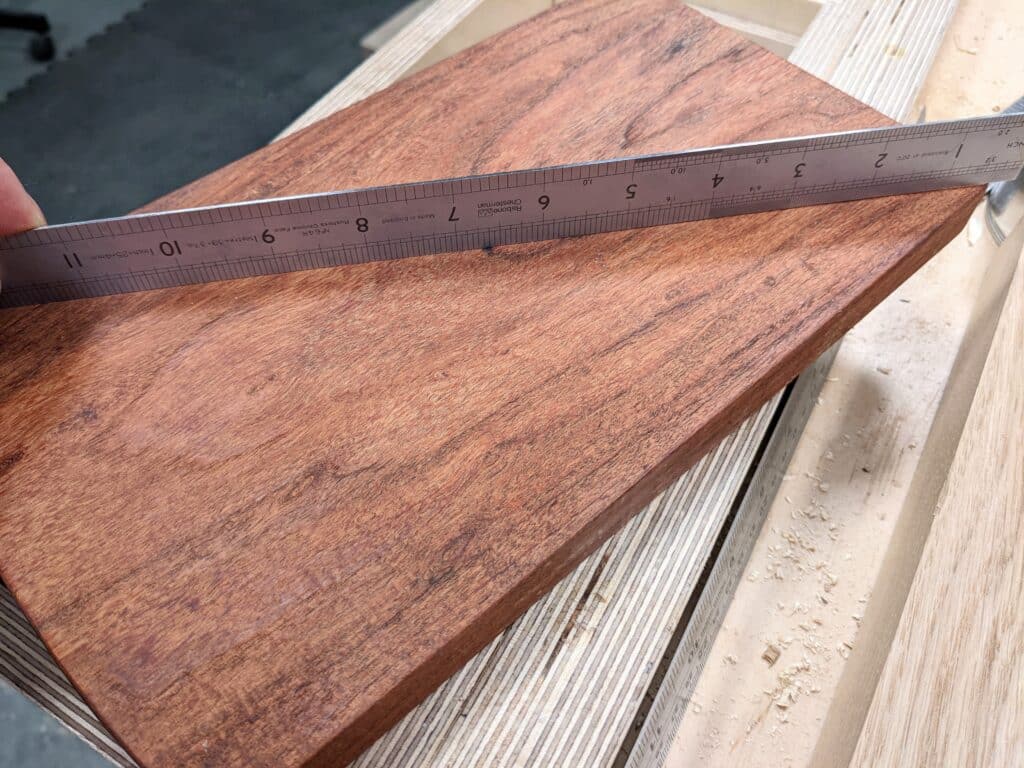
Not only is it a lifetime wood that resists degradation of any kind, more important to me is the fact that it stays dead flat and true year on year. Of course, chopping veggies, meat slicing and general food prep will crisscross-cut the surface fibres over the years and this will hollow the surface somewhat, but I doubt that even in professional realms of cooking, you would see much deterioration over a decade or two.
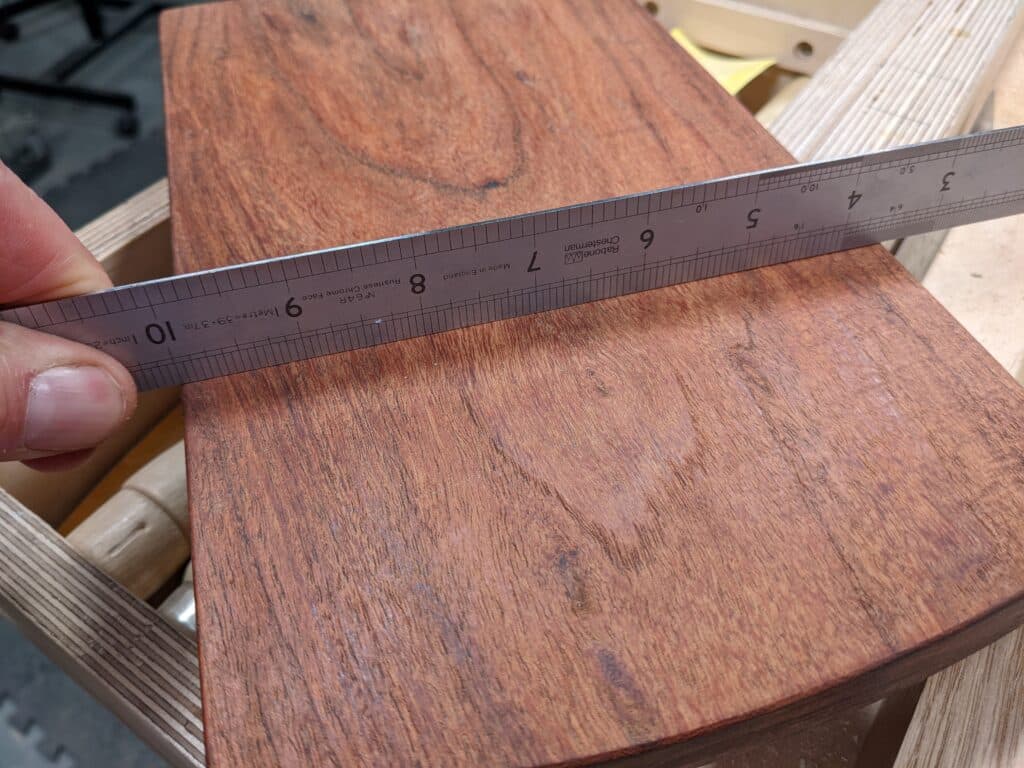
If I ever returned to live in the USA and my home state of `Texas I think I would pursue making cutting boards from mesquite as a business. In times past I have sold a 12″ cutting board 8″ wide for up to $80 US. They take only a few minutes to make and people love the idea that you are NOT barbecuing with it or throwing logs in the fire or bulldozing it and burning it in piles on rangeland. Imagine how narrow-minded the US government was in decades past when they invested millions in trying to eradicate this wonderful legume. The nitrogen fixer of Texas and other states restored more land than it ever deprived us of. It just needed better land management, that’s all.
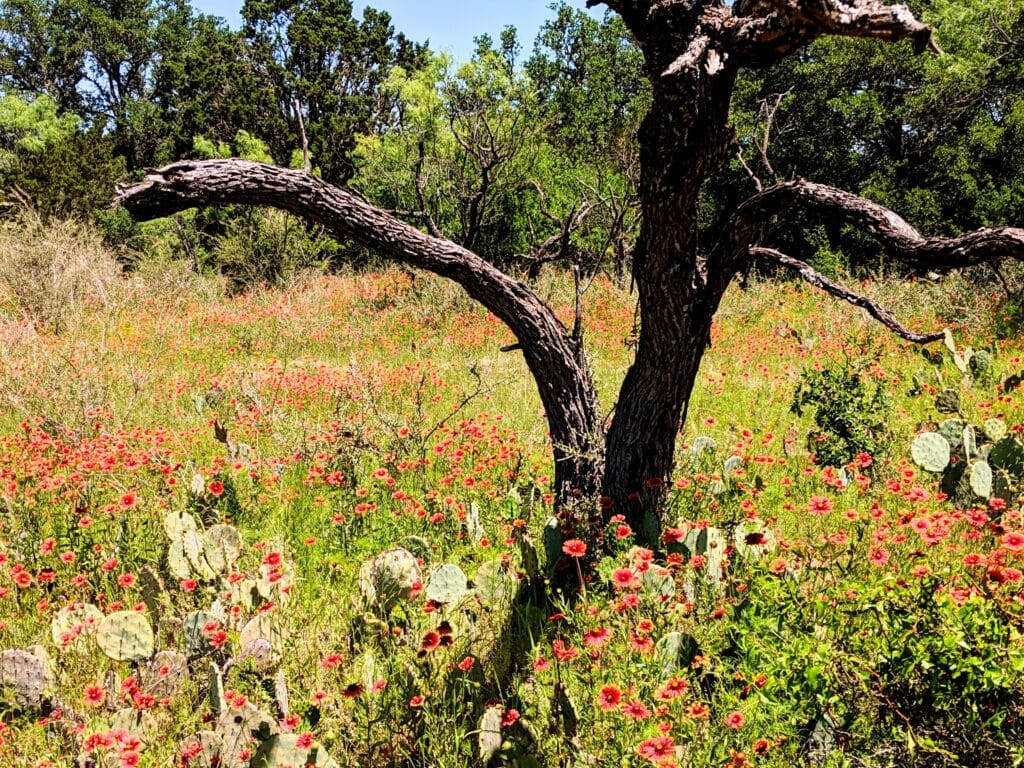


I’d love to hear more about the process from green tree to workable boards. The tree you show looks like youd only get very very small boards once all the bark is removed. Is that a typical size for a mesquite tree (bush?), Or do they get larger so your cutting boards are a single piece?
No, only pic I had at the moment. Great for spoons and spatulas though. When life throws you lemons, make lemonade!
“when life throws you small pieces of mesquite, make spatulas” just isn’t quite as catchy
Or, Paul, trade those lemons for Kentucky Bourbon? 😉
That mesquite picture looks a lot like our dense HardAck trees here in Vermont. I am going to harvest one and see how I can use it. I am sure I am writing the spelling wrong for the tree. It is hard though. Thanks
The mesquite in my front yard here in Arizona is more than a foot in diameter. Not that the owners would like me making it into cutting boards, nor would I like losing the marvelous shade. But I might find a good specimen in someone else’s yard . . .
yea wood is soooo expensive here in AZ
I would love to get some of that beautiful wood
I grew up in San Antonio, Texas and my dad used mesquite for grilling. Later in the ’80s as I picked up woodworking I began to make pieces from the wood. Your description of mesquite’s stability is spot on with my experience. My wife and I have retired to Oaxaca in Mexico and I am able to find mesquite here. Recently my neighbor and I purchased several logs of old mesquite that were destined to become firewood. The logs are about 24″ to 30″ in diameter and 6′ or so long. One piece has a burl like structure you sometimes find in mesquite. I had made my wife a large jewelry box about 25 years ago and used a similar burl like structure and it made a very interesting lid for the box. We have a local saw mill preparing the logs for us.
Sorry but this sounds like fake news. Here in Arizona have never seen a Mesquite tree this large and 6′ long. And we have a lot of Mesquite here. If true, you are lucky and a MARVELOUS piece of wood.
I can vouch for large mesquites though they are scarcer and less common. The largest I cut when living in Texas was 30″, but I have seen bigger on the other side of the Rio Grande. I’m sorry you chose the term, “fake news” too. This is a bit strong and also, just because you have never seen large trees does not mean they don’t exist. I value the truthful contribution, knowing that it is more likely such trees exist in this tenacious tree.
I’m sorry you doubt my post. I tried to attach an image but I’m not able to do so in the blog. I believe trees in Oaxaca can grow large because this area receive more moisture than Arizona. Also Mesquite is not a prized wood for lumber as Pine, Parota, Cedar or Mahogany are here in Oaxaca so the trees are not frequently harvested.
I’m looking for wood with comparable properties available to Europeans. Can you recommend something? I’ve enjoyed working with olive wood for knife handles in the past, but it’s not easy to find stock suitable for cutting boards that doesn’t require filling and isn’t prone to breaking along knot edges. Maybe I should look into using end grain as the cutting surface some more…
Thanks,
George
The advantage of end-grain cutting boards is twofold; one, the knife slides in between the upright fibre ends (which actually part but are not severed and spring back) and not into face grain which inevitably cross-crosses the surface in diamond patterns that gradually flake away in the main cutting area centred in the board. This inevitably results eventually in a hollow to the board but the hollow is not necessarily detrimental. I know of no wood that comes close to mesquite that does not have some transfer of detrimental oils, toxins or flavours. Sycamore has been used in the UK over the previous centuries in kitchen areas for side work tables, draining boards and such and then to cutting and chopping boards. It is not particularly hard but it does make an attractive piece in that it looks fairly white to cream and almost has a sterile appearance that is appealing as a cutting board.
Seems like olive is where it’s at outside of the US. Acacia from southern Europe is used, too, but care should be taken it’s not confused with black locust, because all parts of that are poisonous and their wood may look similar.
I’ll do an end grain olive cutting board as a project sometime soon.
Thanks Paul!
George
Would maybe be a good wood for winding sticks, but I’ve never seen it in the UK.
I would be interested to know how it compares to Laburnum, also a Legume with a dark colour in the heartwood. In parts of northern Italy it seems very common on lower mountain slopes, only saw it cut for firewood. Grows in England but don’t think its native.
Hi Richard, I’d be carful about using laburnum anything involving food. I know the seeds are poisonous. As a child, myself, twin brother & kids in the street ate the seeds off the laburnum Bush in my parents garden.
Fortunately one if the neighbours knew it was poisonous. We all ended up in hospital A&E, stomach pumped & kept in for observation for a few days…I don’t know if the wood is poisonous or toxic… but I recommend you check.. just in case.
Hi Richard. I had a laburnum come down in a storm and thought the ‘oyster’ pattern would look great as a bowl and approached a woodworker friend of mine to get it turned but he advised it’s not suitable for use as anything in contact with food due to it’s toxicity. Great for inlays and marquetry though in furniture.
Do these trees have thorns?
They do, mean ones too. Long and sharp and very strong. Ranchers curse them!
Sounds similar to Osrage Orange (Hedge Apple) that we have up here in the northeast. However, ranchers used them as natural fencelines instead of fighting them. Burnes hot (too hot for standard fireplaces) and grows twisted (but straight staves make sought-after long bow bends).
Hello Joel. The two can never be compared in any way if you come to know both as I have. The best and stoutest, heaviest mallets I have made and owned are made of Bois d’arc. Bois d’arc, the French name for ‘bow wood‘ adapted or adopted from the Indian nation Osage Indian who used the tree for anything including bow making has other names including horse apple, hedge, hedge apple and other local names elsewhere. The wood is the hottest burning wood in North America and is likely the best bow wood of any species due to its incredible strength, elasticity. Additionally, the wood is two and a half times harder than our English oak.
When I visited my brother in Austin TX I bought enough mesquite from the local Woodcraft to make your “Paul Sellers clock.” Noticed the difference in how it behaved relative to oak. Was much harder than oak. No worries. I just sharpened more frequently. There was a very nice fragrance as I worked the wood. I finished the clock with blond shellac and it came out just lovely. I saved all the shavings and gave them to my relative. He is an avid BBQ’er and will use it to smoke the meat. A photo of the clock was published in the Nov catch of projects folks had sent in to your website.
Mesquite is just shy of twice the hardness of oak, Joe, and it’s higher in tannic acid too, but it’s the silica in the wood that dulls the tool edges as it does similarly with teak too. Here’s the link to the gallery everyone:https://woodworkingmasterclasses.com/galleries/wallclock-gallery/
Mesquite is the common name for many plants of the generus Prosopis.
The most representative of them in South America ar Prosopis nigra and Prosopis alba, both know as Algarrobo (negro and blanco respectively).
Algarrobos have dense hard wood, and were intesively used for kitchenware (extremely resistant to boiling water, for instance) until someone discovered they could also be used for low cost furniture. Which is very popular nowadays.
Their wood has a complicated grain, running in every directions, so, it can´t be worked with planes and chisels. Instead, furniture industry uses abrasive tools to shape it.
And, of course, it´s extremely good for firewood!!
Best regards from Argentina
Carlos, I do agree that the grain is more unpredictable but I do not want people to think it can never be worked by hand when it can indeed. Remember, in industry, they do not want to pay skilled workers who, like myself, can work it by hand as I have done over decades. I do think your input was and is valid. People should not expect this wood to work as easily as oak or cherry.
Hi do you know if mahogany is a good wood for chopping boards? I have some spare, and would like to give this a go
It wouldn’t generally be my choice for a cutting board because it is quite soft. I am not sure as to it giving off any other detrimental elements to food. That’s a question of doing the research. . . mesquite is a safe wood.
Noticing that mesquite is a legume, and having a friend who is extremely allergic to a particular protein in legume seeds (though usually not other parts of the plant)… any statement that a wood is “food safe” merits a “usually”. Allergies to particular woods are not unknown, though that usually affects woodworkers more than users. I think the same advice should be applied as with wild foods: if you may not have been exposed to it before, be just a bit careful until you know how you react.
https://en.wikipedia.org/wiki/Janka_hardness_test
There’s a link to a hardness metric for wood with a table of values for many types. As said by Paul, it’s not the only relevant property, though. Potential toxicity, water resistance, porosity, availability etc. all play a role.
Loved to see your article on mesquite as it’s been a favorite of mine for a few years. It’s great to see some recognition for it, it’s color and durability are just what I’m looking for. I live in Arizona where it is common everywhere in the Sonora (although I think it’s a different species then most of the Texas wood) and considered a nuisance by many trying to clear land so a lot of it ends up as firewood or chips. I find it difficult to get it in large, flat, straight stock however which limits my use of it. Several years ago I made two of your Carpenter’s mallets, one from oak and one from mesquite scraps. Because availability I downsized the mesquite to about 2/3 the size of the oak but it was still noticeable heavier but better looking (I can’t bring myself to use it). Generally, I just use linseed oil and leave it in the sun for a day or two to get a deep red color.
As I recall, the US riflemaker, Roy Weatherby, used to use mesquite for his stocks which added to their distinct style.
Cheers.
I have a few small boards from branches I cut from a mesquite tree at my previous house. They are destined to become kitchen tools once I get to them.
After any major storm here in Arizona there are always parts of mesquite trees being ground up or stacked at the curb for disposal!
I spent a good portion of my younger life in Texas and New Mexico. I had no idea that finished mesquite could be that beautiful, Paul! I love the taste it imparts to ribs and steak…equally “tasteful” to the eye!
You lived in Texas? How cool! I have been here in Central Texas since 2007 and have never thought of using that for anything other than smoking a brisket. I’ll have to give that a go! That’s for the insight.
I’ve lived in Austin for the last 15 years also. We have used Mesquite for flooring in several houses. It is very durable, and they glue it to concrete slab floors since there is no expansion. The flooring supplier we have used says the price is increasing and getting harder to get due to commercial buildings such as banks are using it and not just in Texas. The ripple effect of the grain often looks so real you feel it to see if it is flat.
I live in West Texas where Mesquite is plentiful. Though Pecan and Live Oak are preferred, it’s probably the most common shade tree found in the yards in this part of Texas because it was probably already growing in the yard when the houses were built and “ready shade” in this part of the country is appreciated. It’s pretty much disease free, requires little to no maintenance and will survive a West Texas drought better than any other tree. They tend to grow with a lot of “character” and are very “climbable”. Kids love them. There are over forty varieties of Mesquite. Not all of them have thorns. Ranchers and farmers have tried to eradicate it because it can absorb so much of our precious ground water and their expansion and growth can overwhelm a lot of acreage quickly that would, otherwise, be used for grazing or farming. Because of it’s abundant ability to absorb groundwater, the government has spent millions trying to kill it out and clear it from acreage near our lakes and streams, we still have an abundant supply and it is one of the more prevalent preferred sources for cheap firewood. I used mesquite to make a fret board and bridge for my son’s guitar. I think it worked out well and have gotten many compliments on it. I enjoyed your post and your cutting board photo is an inspiration.
My twin brother made a pool table from mesquite, it’s dimensional stability was perfect for the job. He bought it from a supplier in the San Antonio area and had it shipped to him in Northern California.
Several years ago I was south of Tucson Arizona on vacation and stopped at a sawmill/lumber store where I had been told I could buy mesquite. I was amazed at how much mesquite they had cand how expensive it was. I ended up with one piece I could carry in my car. I have made pens, tips for kayak paddles I have made and a few other items. I love how the wood works and finishes. My one regret is I did not buy a lot more and Minnesota it is a long drive to Arizona.
My brother lives in Austin, I in Houston. I’m planning on driving out that direction later in the year to pick up some mesquite to make your dining chair for him as a gift, to fit with his Hill Country vibe. I made one last year in African mahogany and it turned out gorgeous.
Any species- (or family-) specific things to look for in rough mesquite stock?
Also, this is probably neither the time nor place, but are there plans for Sellers’ Home to include a bed design?
I’m not familiar with Mesquite, so I did some searching and found this article fascinating: https://www.desertusa.com/flora/mesquite-tree.html
I live in Tombstone Arizona. I’ve harvested many many mesquite trees including the root burls. Some of the hearts of the roots can be 3 foot in diameter. It’s my favorite wood. It’s hard and sturdy but it also cuts very well with hand tools and it carves so beautifully with hand gouges and chisels. The tool bevel leaves a burnished polished surface. I’ve made cabinets, fireplace mantels and surrounds and all manner of furniture. The cambium layer is bright yellow but wood eating bugs love that layer and turn it into sawdust very quick. If you complete a project then coat it in boiled linseed oil and put it in the hot sun after it dries and the wood will turn the most rich amazing red color. I always seem to have some good sized mesquite logs laying around my property waiting their turn to be made into some creation.